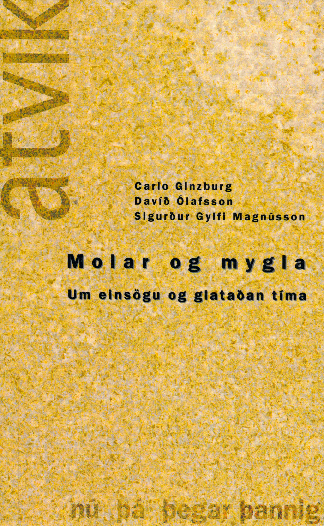 Pieces and Molds. About Microhistory and Lost Time. Incidence 5. Co-authorship with Carlo Ginzburg and Davið Ólafsson. Published by the Reykjavik Academy and Bjartur Publishing, 2000. 147 pages. – (Molar og mygla. Um einsögu og glataðan tíma. Atvik 5. Meðhöfundar Carlo Ginzburg og Davíð Ólafsson. Ritstjórar Ólafur Rastrick og Valdimar Tr. Hafstein (Reykjavik, 2000)).
Pieces and Molds. About Microhistory and Lost Time. Incidence 5. Co-authorship with Carlo Ginzburg and Davið Ólafsson. Published by the Reykjavik Academy and Bjartur Publishing, 2000. 147 pages. – (Molar og mygla. Um einsögu og glataðan tíma. Atvik 5. Meðhöfundar Carlo Ginzburg og Davíð Ólafsson. Ritstjórar Ólafur Rastrick og Valdimar Tr. Hafstein (Reykjavik, 2000)).
This book was published the year 2000 and is a volume co-authored by Carlo Ginzburg, Davíð Ólafsson and myself entitled Pieces and Molds: About Microhistory and Lost Time (Incidence 5). Among the essays in this book was a piece by myself in which I discuss certain new ideas I was working on at the time under the general label of ‘the Singularization of History’; included in this was a broad critique of what I termed ‘the concept of general approach’ and which I considered characteristic of the Icelandic history establishment. The main thrust of my criticism was directed at the overriding importance that this establishment accorded to general history or synthesis as a way of approaching historical issues. Another article in the volume, by Davíð Ólafsson, dealt with the connections between Icelandic historiography and postmodernism.
These two articles, together with Carlo Ginzburg’s comments on the prehistory of microhistory (called: “Microhistory: Two or three things that I know about it“), had the desired effect: many saw them as an assault on the basis of history as an academic discipline and the epistemological foundations on which it rests. My article put forward the view that the connecting of smaller units to greater wholes should by no means be taken for granted, as something to be carried out as a matter of course; on the contrary, there were great dangers inherent in this approach, since it involved an ever-present danger of the findings being determined by a preconceived grand narrative. In other words, I was presenting ideas that drew on the ideologies of postmodernism and poststructuralism, neither of which had previously achieved much prominence in academic circles in Iceland.
See the summary of my article:
Microhistory – as a field of study – has been in the making for the past twenty years in most of Europe and North America, but it took shape somewhat earlier in Italy around the journal Quaderni Storici, in the hands of historians such as Carlo Ginzburg, Giovanni Levi, Edoardo Grendi, and Gianna Pomata. While this essay touches on the views and works of these scholars, its main focus is on the rise in interest in microhistory across the globe in the last decade and on the topics of recent microhistorical research. The essay pays particular attention to one element common to the theoretical orientations of all microhistorians, viz. the connections between micro and macro.
Microhistorians of all persuasions emphasize the importance of placing small units of research within larger contexts. Until recently, the author adhered to this principle in his investigations. In this article, however, he seeks to refute this principle and show its inherent contradictoriness. The article explores the implications of this move for the epistemological grounding of microhistory.
After discussing the defining characteristics of microhistory, the author examines two currents within the Italian school, one closely tied to conventional social history, the other more in line with the new cultural history. The distinctions between these two approaches are presented, and the case is that they are connected with the work of several American scholars, none of whom is a microhistorian, but all of whom are proponents of grand historical narratives. This article takes a resolute stance against grand narratives such as modernization theory on the grounds that they are constructions which, when invoked, almost inevitably mold historical research in their own image. Thus, research so informed comes to revolve about something unrelated to knowledge of the past.
As an alternative to accepting the guidance of grand narratives, the author advances an approach that he proposes to call the “singularization of history”. Taking this approach involves scrutinizing the details and nuances of the events and objects of research and looking for meaning within them, rather than in larger contexts.
The author encourages historians to cut the umbilical cord that ties them to grand historical narratives, but he is aware that this is not an easy task, as the grand narratives inform the conventional codes of scientific research. In order to circumvent these narratives, the author suggests a procedure he calls “historicalization” whereby a work is 1) estimated on its own merit; 2) compared to other works in the same field of inquiry; and 3) placed in a larger context of general ideas about the development of societies, constructed by grand narratives. Historicalization is thus a methodology for the singularization of history, designed to promote its credibility in general scholarship, within which it must necessarily function and vie for influence.
The article severely critiques the conventional theoretical framework of microhistorical research and attempts to redefine the aims and parameters of microhistory in order for it to achieve its full potential. The “singularization of history” shows the way.
